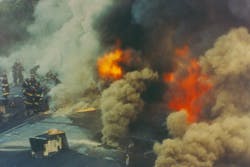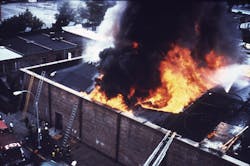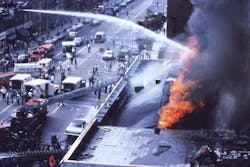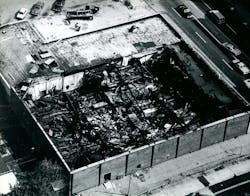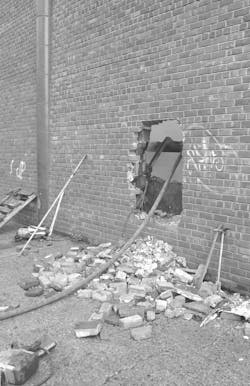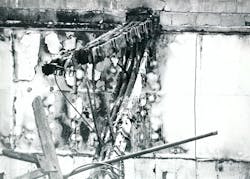Many of the more infamous fires in the history of the FDNY are given a name. The names are short, but the list is long: Father’s Day, 9/11, Third Avenue Collapse, Wooster Street, Fitzpatrick/Frisby, Deutsche Bank, Watts Street, 23rd Street Collapse, Black Sunday, to name a few.
On Aug. 2, 1978, the FDNY responded to a fire in a supermarket at 2892 Ocean Ave. in the Sheepshead Bay section of Brooklyn. This was a landmark fire in the FDNY and prompted a sea change in the way we approach fires involving trusses. The name of the fire is simply Waldbaum’s.
The building
The roof was supported by seven 100-foot-long heavy timber bowstring trusses spaced 20 feet apart, and each measured 10-foot, 1-inch high from the top chord to the bottom chord at the apex of the truss. There were sloping hip rafters that connected the first truss and the last truss to the front and rear walls. The trusses were numbered front to rear. All the even-numbered trusses, which were covered with sheetrock, had a doorway so that workers could pass back and forth within the trusses. The characteristic curved roof shape that would indicate a bowstring truss roof support system was not visible from the street.
Rainwater did not drain off the roof due to a sagging roof, so a “rain roof” had been installed, recreated the curve of the roof so rainwater could drain away. Running the length of the building, the rain roof was constructed of wooden beams and a roof deck that was on top of the old roof deck. The original roof deck was 6 to 8 inches below the new rain roof.
There were two ceilings—a drop ceiling and an older tin ceiling above it. The tin ceiling was not removed when the new ceiling was installed. The drop ceiling was 18 inches below the ornamental tin ceiling, which was attached to the bottom chord of the trusses and purlins. The original tin ceiling was 16 feet above the floor. There were renovations going on within the store while it was still occupied and open to the public.
The fire
Engine 254, commanded by Lt. Edward Smith, arrived at the box. He saw flames near the exposure 4 side roof level near where the extension was being constructed. He transmitted a 10-75 at 8:45 a.m. Smith ordered his members pull one 1¾-inch handline and one 2½-inch handline from the hosebed. Smith was told that the fire was in the mezzanine area. Engine 254 started stretching the 1¾-inch handline through the front door toward the stairway of the mezzanine.
Ladder 153 was the first-due ladder company on scene, led by Lt. Peter Simeone, with Firefighters George Rice (roof), James McManus (outside vent), Frederick Bennis (chauffeur), Donald Livingston (can) and John Fitzpatrick (irons).
Simeone was told that the fire was on the second floor (mezzanine). There was no visible fire, but there was a light smoke condition. Ladder 153’s inside team was assisting in clearing a path for the hoseline and performing a search. The ceilings were being opened. The roof and outside vent firefighters went to the roof to perform vertical ventilation.
Battalion Chief Arthur Clark of Battalion 33 arrived shortly after Engine 254 and Ladder 153. He transmitted the “All Hands” for box 3300 at 8:49 a.m.
Engine 321 and Ladder 156 arrived at the fire. Engine 321, led by Lt. Tim Howard, assisted Engine 254 in getting the first handline into position. Howard observed that there was no fire, just a light smoke condition within the store. They stretched the 2½-inch handline as a backup to the first hoseline.
Engine 276 arrived and began stretching a 2½-inch hoseline through the one-story extension on the exposure 4 side due to seeing smoke in this area. The crew saw fire in the openings in the wall leading to the mezzanine in the original building.
The time was 8:54 a.m. Engine 254 started operating their hoseline into the ceiling. The heat was much more intense in the mezzanine area. There was little smoke. Clark requested an additional engine and ladder to be sent to the fire.
Ladder 156—Lt. James Cutillo; Firefighters Charles Bouton (roof), Donald King (outside vent) and Terrence Campbell (chauffeur, detailed from Ladder 153); and Probationary Firefighters William “Billy” O’Connor (irons) and Thomas Higgins (can)—then began their operations. The forcible entry team initially went into the building to check on conditions. The remaining members of Ladder 156 went to the roof to begin vertical ventilation.
Battalion 42 was the second battalion chief to arrive. Battalion Chief Peter Eisemann and Firefighter Harold Hastings were on duty. Eisemann saw smoke in the area, but nothing to be alarmed about. He reported into Clark. Clark told Eisemann to supervise roof operations.
Ladder 169 arrived at the fire with Firefighter John Madigan and Probationary Firefighter Harold Plaut. Clark ordered them to take their saw to the roof and assist with vertical ventilation, as they were having difficulty cutting through the “rain roof.” But they had reported that the roof seemed solid to them.
Deputy Chief James O’Malley of the 12th Division arrived at the fire at 9 a.m. Clark filled him in as to the assignments already given. He was told that he had no exposure problems and that Battalion 42 was supervising roof operations. O’Malley then sent Clark into the store to supervise operations there. O’Malley transmitted a second alarm at 9:02 a.m.
Rescue 2 was sent to the fire on the 10-75 signal. Firefighter Tom Vallebuona went to the roof, and the remaining members of Rescue 2 went to operate inside the store.
Conditions on the roof were different from those inside the store. Ladders 153 and 156 were cutting with their saws. Scuttle covers were removed and the scuttles showed heavy smoke. At first, there was very little smoke coming out of the cuts. The members operating on the roof did not know that there was a double roof installed, and it took some time for the members to identify the rain roof. The original roof would have had to be cut after the rain roof had been cut. This was not workable due to the depth of the original roof. So members moved the cutting operations away from the center of the roof and those holes showed heavy smoke. The roof seemed solid. The roof conditions were indicative of a more severe fire condition than was being observed inside the store.
Eisemann observed fire encroaching upon the air conditioner on the roof that was supported by wooden beams. At this time, he requested an additional hoseline on the roof due to the large area of the roof.
At 9:10 a.m., O’Malley requested an additional engine as well as a tower ladder.
Conditions on the inside of the store seemed to be improving. Engine 254 was hitting fire in the ceiling of the mezzanine. The smoke condition was light to moderate. Members of Ladder 153 and Rescue 2 were pulling ceilings to gain better access to the fire.
The collapse
There were 24 members operating on the roof. Conditions on the roof were much more severe than they were inside the store. Heavy smoke and fire was showing near vent cowls and holes that were cut, but the roof still felt strong.
Suddenly, a section of the roof folded in. There was no sound. There was no vibration. A 4,000-square-foot area opened and erupted into intense fire. Twelve firefighters were swallowed into the fire: From Ladder 156, Cutillo, Bouton, O’Connor, Campbell (detailed from Ladder 153) and King; from Ladder 153, McManus and Rice; from Rescue 2, Vallebuona; from Ladder 169, Madigan and Plaut; from Battalion 42, Hastings; and from Engine 246, Firefighter William Kelly.
O’Malley, standing at the Command Post in the street, started to see a heavier volume of smoke coming out the front of the building. There was no loud sound. There was nothing to indicate to him that a collapse had occurred. Then suddenly, firefighters came stumbling out of the front of the store. O’Malley ran to one of the firefighters coming out and the firefighter said, “There’s men in there.”
It was 9:16 a.m. O’Malley transmitted a third alarm. One minute later, he transmitted a fourth alarm. The collapse of truss number five happened approximately 32 minutes after the arrival of the first unit.
On the roof, members who had not fallen into the fire were scrambling to get to the parapet wall. Eisemann grabbed Engine 254’s hoseline and operated it as a protection line so that members could make it to an aerial ladder on the exposure 2 side. Firefighter Pat Mahaney of Ladder 169, seeing that Eisemann was close to falling into the blazing hole, started yelling, “The chief is going in!” Mahaney ran across the parapet and grabbed Eisemann.
Inside the store, a sound of a falling wooden timber was accompanied by a sudden eruption of fire in the rear of the store. It wasn’t readily apparent what had just happened. The smoke condition worsened.
Firefighter Jack Pritchard of Rescue 2 was near the front of the store when the collapse occurred. He stumbled upon an injured Vallebuona, who had fallen from the roof into the truss area and onto the tin ceiling.
Vallebuona had been in in complete blackness inside the truss void for a few seconds, and then it lit up. He could hear some of the other firefighters who fell into the truss area, and yelled for help. He got low and saw a hole. He dove for the hole and fell to the floor of the store where Pritchard found him.
Vallebuona said to Pritchard, “I think members are still in there” and then led Pritchard to the area near the Avenue Y side. Pritchard told Vallebuona to leave the area. Pritchard started searching and found a firefighter who was dazed and injured. He led that firefighter to the front of the store, went back in and found a second and a third firefighter. The third firefighter was caught on a shelf. He was pulled out and removed to the front of the store.
Firefighters King, Plaut, Madigan, Campbell, Kelly and Vallebuona had fallen through the truss area to the floor of the store. Some of them had to punch their way through the ceiling. Some were initially hung up on cables before they fell through to the floor of the store. They all were severely injured.
That left six firefighters still hung up in the truss area: Cutillo, Hastings, Bouton, Rice, McManus and O’Connor. The truss area of the building was a raging inferno. They all fell into the hole between trusses 4 and 6, closer to truss 4.
The rescue effort
The remaining roof collapsed in the front of the store shortly after all operating firefighters were in the street. An emergency roll call was ordered by Deputy Assistant Chief John Stancarone, who had sectored off the rescue effort.
The rescue efforts in front of the store were particularly hazardous due to the front truss and the sloping hip rafters hanging precariously overhead. Engines 254, 248, 281 and Rescue 2 were trying to get through via the front of the store. The exposure 2 side (Avenue Y) was a point of attack to rescue the missing firefighters. Firefighters from Rescue 2 and Ladder 161 used a battering ram to breech a hole in the wall near where Truss 5 would have been located.
Rescue 1 arrived and entered via the breeched wall and looked to relieve Rescue 2. Also working feverishly were members from Rescue 3.
As the searching firefighters continued their mission, firefighters moved into an area where there was an aisle. One of them said, “We found a 6-foot hook.” Then, a firefighter’s helmet was found. Curran looked around closely and said, “There they are.” He had found two of the fallen firefighters.
Realizing that the other missing members could be nearby, the firefighters were straining to look through the heavy smoke condition. Firefighter George Kreuscher of Rescue 1 started pulling roofing material apart near his location. Suddenly, the other four fallen firefighters were discovered, thus beginning the grim task of recovering the bodies and carrying them out of the building. They were covered and carried out on Stokes basket stretchers.
The fire was placed under control at 12:45 p.m. Twenty-five firefighters were injured and ultimately required medical leave.
Final thoughts
This fire was horrific. To this day, some hardened, veteran firefighters who were at this fire still become emotional when talking about the events of Waldbaum’s.
There were six wives who lost their husbands and 18 children who were left fatherless as a result of this fire. We honor the firefighters who lost their lives:
· Lt. James E. Cutillo, Battalion 33 (working in Ladder 156)
· Firefighter Charles S. Bouton, Ladder 156
· Probationary Firefighter William O’Connor, Ladder 156
· Firefighter James P. McManus, Ladder 153
· Firefighter George Rice, Ladder 153
· Firefighter Harold F. Hastings, Battalion 42
May they all rest in peace. Never forget!
Thank you to the following people who contributed to this article: Deputy Chief Vincent Dunn (ret.), Battalion Chief John (Jack) Pritchard (ret.), Captain Phillip Ruvolo (ret.), Lt. Thomas Higgins (ret.), Battalion Chief Thomas Vallebuona (ret.), FDNY Safety Battalion, Fire Marshal Dan Maye (Mand Library), Katie Clements (FDNY Photo Unit), Leslie Ifill (Fire Records Unit), Captain Patrick Mahaney (ret.), Lt. John Scasny (ret.), and Firefighter Chris Roberto.
Resources
Brannigan, F. “Building Construction for the Fire Service”, 3rd Edition. 1993.
DiMaria, E. “Fire: A War That Never Ends.” 1978.
Dunn, V. “Collapse of Burning Buildings: A Guide to Fireground Safety.” 2nd Edition. 2010.
“FDNY Firefighting Procedures, Taxpayers.”
“Fire Report from Brooklyn Box 4-4-3300.”
Flood, J. “The Fires: How a Computer Formula, Big Ideas, and the Best of Intentions Burned Down New York City—and Determined the Future of Cities.” 2011.
Kreuscher, G. “Fireman.” 2008.
Report from Deputy Assistant Chief John Stancarone to Fire Commissioner Augustus A. Beekman.
Sidebar: Trusses
Bowstring trusses are designed by engineers. The original tensile strength of the wood may have deteriorated over the years. It is estimated that bowstring truss roofs may only support 40 percent of their originally designed load-carrying capacity. Beware of any alteration of trusses. Any alteration of a truss is contrary to its design and is dangerous.
Bowstring trusses are spaced 10 to 20 feet apart. In the case of Waldbaum’s, the trusses were spaced 20 feet apart. Initially, only one truss failed. The failure of the one truss opened up an area 40 feet x 100 feet.
If you find yourself on a bowstring truss roof that is in danger of collapse, you should move to the next safe truss and then to the parapet wall. If you are in the center of a roof that is supported by a bowstring truss, you are 50 feet away from the parapet wall. If you head for the parapet wall first, you may go down if the truss collapses. By going to the next safe truss, then to the parapet wall, you may temporarily be safe as you make your way off the roof.
Identifying a truss roof support system is a key step in ensuring firefighter safety. Never assume that the chief in command can see what you see. If you are on a roof and you identify a truss, communicate that to the chief.
When a chief officer receives conflicting reports about the severity of the fire between the roof firefighters and the interior firefighters, the chief must act on the most severe report. Two of the most deadly bowstring truss fires had conflicting size-up reports. Both Waldbaum’s and the 1988 fire at the Hackensack, NJ, Ford Dealership that killed five firefighters showed a much more severe fire condition on the roof than inside the building.
“Under no circumstances shall any member operate on the roof of any building involved in a content or structural fire with a wooden, metal or combination bowstring truss design.” — FDNY Firefighting Procedures Taxpayers,” Section 5.5.25.
About the Author
John "Jay" Jonas
Deputy Chief John “Jay” Jonas is a 38-year veteran of the FDNY. He is assigned to Division 7 in the Bronx. Jonas is the author of the Division 7 Training and Safety Newsletter. In addition to working in the Bronx, he has worked in the Lower East Side, Chinatown and Greenwich Village sections of Manhattan. Jonas has a bachelor’s degree in fire administration from Empire State College, SUNY, and an associate of applied science degree in fire science from SUNY Orange. He is also a graduate of FDNY's Fire Officer's Management Institute (FOMI).
